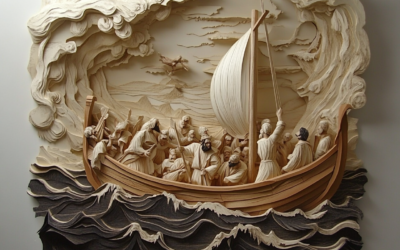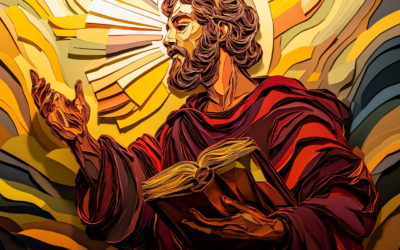Matthew doesn’t exactly burst onto the scene with charisma. He shows up in a toll booth. He’s a tax collector, the kind of guy your grandmother would pray against by name. Working for Rome. Skimming off the top. Socially untouchable. Spiritually exiled. And yet—Jesus walks by, says two words (“Follow me”), and suddenly the man’s an apostle. Just like that. No theological resume, no public repentance, no dramatic conversion speech. He gets up, walks away from the money table, and starts writing Scripture.
What happened to him after that? Depends who you ask. The earliest Christian sources say he preached to his own people in Judea before heading east—maybe to Persia, maybe Ethiopia, maybe somewhere no one could spell. Roman Catholic tradition claims he was stabbed to death. Eastern Orthodoxy remembers him every November 16. The Western Church prefers September 21. Whichever calendar you follow, he went down swinging.
In Christian art, he’s got wings. Not because he flew, but because he opened his Gospel with a genealogy—a long, dusty line of fathers and sons. To early Christians, that made him the Gospel writer who captured Christ’s humanity. A tax man turned biographer. A paper-pusher turned prophet. Strange career path. Stranger legacy. But it stuck.
Modern Scholarship: Red Ink and Rolled Eyes
These days, if you throw a rock into a seminary library, you’ll hit three scholars arguing over whether Matthew actually wrote Matthew. The Gospel that bears his name copies huge swaths of Mark—sometimes word-for-word in Greek. That raises eyebrows, especially if you’re trying to claim it came from an eyewitness. Why would an apostle lean so hard on a secondhand account?
Enter the infamous Q source—short for “Quelle,” the German word for “source.” It’s a hypothetical document that supposedly held all the sayings of Jesus both Matthew and Luke used. No one’s ever seen it, but that hasn’t stopped generations of scholars from diagramming it to death. Alongside Q comes redaction criticism, which basically asks: What did the Gospel writer change, and why?
Still, the early Church wasn’t stupid. They slapped Matthew’s name on this Gospel because it read like a tax man wrote it: neat columns, Jewish citations, and a detailed interest in numbers (forty-two generations, anyone?). Even if a later scribe polished it up, the bones feel personal. Structured. Careful. Like someone who used to count coins but now counts promises fulfilled.
The Later Life and Legacy of Matthew: Fog, Fire, and Feast Days
Once Matthew dropped his coin pouch and followed Jesus out the door, history gets real murky. The kind of murky that scholars argue about for centuries while scribbling footnotes in twelve languages.
Some early sources—think Eusebius, Clement of Alexandria, and Origen, those ancient seminary rockstars—claim Matthew stayed in Judea for a while after the resurrection, teaching and baptizing until the local synagogues started throwing more curses than compliments. After that, depending on who you ask, he packed up and went east. Way east. Options include:
- Ethiopia — though not the modern state, but a Roman definition that could mean anywhere south of Egypt. A lot of Church Fathers (like Rufinus) say this is where Matthew eventually met his bloody end.
- Parthia — which was the Persian Empire’s cooler, sassier cousin. If he ended up here, he would’ve been preaching in a land known for magi and armies on horseback.
- Syria or Persia — depending on which medieval monk you quote, Matthew was either converting Zoroastrians or dodging daggers.
The Roman Catholic tradition is pretty blunt: Matthew was stabbed to death while celebrating the Eucharist. Picture that—holding up the bread, saying “this is my body,” and someone takes it literally with a blade. Brutal poetry.
Foxe’s Book of Martyrs puts the scene in a city called Nad-Davar, where the king’s lusty interest in Matthew’s converts got him rebuked. That never ends well. The king had him nailed to the ground and decapitated. Charming bedtime reading.
The Eastern Orthodox Church commemorates his life on November 16. The Western Church throws his feast on September 21. Pick your liturgical flavor. Different calendars, same apostle.
The Man with Wings: A Strange and Symbolic Portrait
If you ever walk into a cathedral and see four creatures holding up a Bible like celestial security guards, Matthew’s the one with the human face and wings. Looks like a weird angel accountant. That’s not a coincidence.
According to Irenaeus, Jerome, and others with dusty beards and dangerous amounts of ink, each Gospel writer gets a living creature from Ezekiel’s vision (Ezekiel 1:10) and John’s Revelation mash-up (Revelation 4:7). Matthew gets the winged man because his Gospel starts with a genealogy—Abraham to Jesus in one long list of who-begat-whom—and that emphasizes Christ’s humanity. No talking donkeys or lightning bolts. Just real names. Human bloodlines. Family drama.
Here’s how the rest of the heavenly zoo shakes out:
- Matthew: Winged man – Jesus as the Human Messiah
- Mark: Winged lion – Jesus as bold, roaring servant
- Luke: Winged ox – Jesus as sacrificial workhorse
- John: Eagle – Jesus as divine high-flyer
The winged man is often drawn holding a scroll or quill. Sometimes a book. Occasionally he’s got a slightly anxious expression, like someone who just realized he forgot to pay his taxes. Irony runs deep in Church art.
The iconography is symbolic, sure. But also kind of fitting. Matthew the bean counter turned gospel writer gets to be the evangelist who reminds the world that Jesus didn’t just zap into existence. He came through a bloodline. He had ancestors. He was born. And that makes Him one of us.
From ledger sheets to feast days to stained glass, Matthew left a mark a lot deeper than taxes ever could.
From Ledgers to Letters: Why Matthew Still Matters
Matthew’s story is proof that your worst reputation isn’t bigger than Christ’s invitation. He didn’t clean up his act and then get called. He got called and then changed forever. His Gospel is structured, relentless, and obsessed with pointing back to Scripture. If Mark is the action movie, Matthew is the courtroom drama—methodical, thorough, and aimed at the Jewish mind like a theological sniper.
We don’t know how he died. We don’t know where exactly he went. But we know he dropped his day job and followed a man who turned dinner tables into altars and sinners into saints.
And we’ve been quoting him ever since.
Scripture quotations taken from the (NASB®) New American Standard Bible®, Copyright ©, 2020 by The Lockman Foundation. Used by permission. All rights reserved. lockman.org









0 Comments